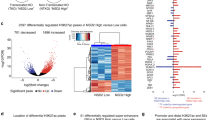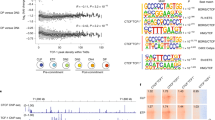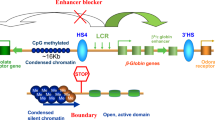Abstract
Long-range chromatin interactions control metazoan gene transcription. However, the involvement of intra- and interchromosomal interactions in development and oncogenesis remains unclear. TAL1/SCL is a critical transcription factor required for the development of all hematopoietic lineages; yet, aberrant TAL1 transcription often occurs in T-cell acute lymphoblastic leukemia (T-ALL). Here, we report that oncogenic TAL1 expression is regulated by different intra- and interchromosomal loops in normal hematopoietic and leukemic cells, respectively. These intra- and interchromosomal loops alter the cell-type-specific enhancers that interact with the TAL1 promoter. We show that human SET1 (hSET1)-mediated H3K4 methylations promote a long-range chromatin loop, which brings the +51 enhancer in close proximity to TAL1 promoter 1 in erythroid cells. The CCCTC-binding factor (CTCF) facilitates this long-range enhancer/promoter interaction of the TAL1 locus in erythroid cells while blocking the same enhancer/promoter interaction of the TAL1 locus in human T-cell leukemia. In human T-ALL, a T-cell-specific transcription factor c-Maf-mediated interchromosomal interaction brings the TAL1 promoter into close proximity with a T-cell-specific regulatory element located on chromosome 16, activating aberrant TAL1 oncogene expression. Thus, our study reveals a novel molecular mechanism involving changes in three-dimensional chromatin interactions that activate the TAL1 oncogene in human T-cell leukemia.
This is a preview of subscription content, access via your institution
Access options
Subscribe to this journal
Receive 12 print issues and online access
$259.00 per year
only $21.58 per issue
Buy this article
- Purchase on Springer Link
- Instant access to full article PDF
Prices may be subject to local taxes which are calculated during checkout








Similar content being viewed by others
References
Aplan PD, Begley CG, Bertness V, Nussmeier M, Ezquerra A, Coligan J et al. The SCL gene is formed from a transcriptionally complex locus. Mol Cell Biol 1990; 10: 6426–6435.
Begley CG, Aplan PD, Davey MP, Nakahara K, Tchorz K, Kurtzberg J et al. Chromosomal translocation in a human leukemic stem-cell line disrupts the T-cell antigen receptor delta-chain diversity region and results in a previously unreported fusion transcript. Proc Natl Acad Sci USA 1989; 86: 2031–2035.
Chen Q, Yang CY, Tsan JT, Xia Y, Ragab AH, Peiper SC et al. Coding sequences of the tal-1 gene are disrupted by chromosome translocation in human T cell leukemia. J Exp Med 1990; 172: 1403–1408.
Finger LR, Kagan J, Christopher G, Kurtzberg J, Hershfield MS, Nowell PC et al. Involvement of the TCL5 gene on human chromosome 1 in T-cell leukemia and melanoma. Proc Natl Acad Sci USA 1989; 86: 5039–5043.
Robb L, Lyons I, Li R, Hartley L, Kontgen F, Harvey RP et al. Absence of yolk sac hematopoiesis from mice with a targeted disruption of the scl gene. Proc Natl Acad Sci USA 1995; 92: 7075–7079.
Shivdasani RA, Mayer EL, Orkin SH . Absence of blood formation in mice lacking the T-cell leukaemia oncoprotein tal-1/SCL. Nature 1995; 373: 432–434.
Robb L, Elwood NJ, Elefanty AG, Kontgen F, Li R, Barnett LD et al. The scl gene product is required for the generation of all hematopoietic lineages in the adult mouse. Embo J 1996; 15: 4123–4129.
Porcher C, Swat W, Rockwell K, Fujiwara Y, Alt FW, Orkin SH . The T cell leukemia oncoprotein SCL/tal-1 is essential for development of all hematopoietic lineages. Cell 1996; 86: 47–57.
Hu X, Ybarra R, Qiu Y, Bungert J, Huang S . Transcriptional regulation by TAL1: a link between epigenetic modifications and erythropoiesis. Epigenetics 2009; 4: 357–361.
Cardoso BA, de Almeida SF, Laranjeira AB, Carmo-Fonseca M, Yunes JA, Coffer PJ et al. TAL1/SCL is downregulated upon histone deacetylase inhibition in T-cell acute lymphoblastic leukemia cells. Leukemia 2011; 25: 1578–1586.
Hu G, Schones DE, Cui K, Ybarra R, Northrup D, Tang Q et al. Regulation of nucleosome landscape and transcription factor targeting at tissue-specific enhancers by BRG1. Genome Res 2011; 21: 1650–1658.
Dhami P, Bruce AW, Jim JH, Dillon SC, Hall A, Cooper JL et al. Genomic approaches uncover increasing complexities in the regulatory landscape at the human SCL (TAL1) locus. PLoS ONE 2010; 5: e9059.
Ogilvy S, Ferreira R, Piltz SG, Bowen JM, Gottgens B, Green AR . The SCL +40 enhancer targets the midbrain together with primitive and definitive hematopoiesis and is regulated by SCL and GATA proteins. Mol Cell Biol 2007; 27: 7206–7219.
Delabesse E, Ogilvy S, Chapman MA, Piltz SG, Gottgens B, Green AR . Transcriptional regulation of the SCL locus: identification of an enhancer that targets the primitive erythroid lineage in vivo. Mol Cell Biol 2005; 25: 5215–5225.
Gottgens B, Barton LM, Chapman MA, Sinclair AM, Knudsen B, Grafham D et al. Transcriptional regulation of the stem cell leukemia gene (SCL)—comparative analysis of five vertebrate SCL loci. Genome Res 2002; 12: 749–759.
Gottgens B, Barton LM, Gilbert JG, Bench AJ, Sanchez MJ, Bahn S et al. Analysis of vertebrate SCL loci identifies conserved enhancers. Nat Biotechnol 2000; 18: 181–186.
Follows GA, Dhami P, Gottgens B, Bruce AW, Campbell PJ, Dillon SC et al. Identifying gene regulatory elements by genomic microarray mapping of DNaseI hypersensitive sites. Genome Res 2006; 16: 1310–1319.
Silberstein L, Sanchez MJ, Socolovsky M, Liu Y, Hoffman G, Kinston S et al. Transgenic analysis of the stem cell leukemia +19 stem cell enhancer in adult and embryonic hematopoietic and endothelial cells. Stem Cells 2005; 23: 1378–1388.
Gottgens B, Gilbert JG, Barton LM, Grafham D, Rogers J, Bentley DR et al. Long-range comparison of human and mouse SCL loci: localized regions of sensitivity to restriction endonucleases correspond precisely with peaks of conserved noncoding sequences. Genome Res 2001; 11: 87–97.
Bockamp EO, McLaughlin F, Murrell AM, Gottgens B, Robb L, Begley CG et al. Lineage-restricted regulation of the murine SCL/TAL-1 promoter. Blood 1995; 86: 1502–1514.
Gottgens B, Broccardo C, Sanchez MJ, Deveaux S, Murphy G, Gothert JR et al. The scl +18/19 stem cell enhancer is not required for hematopoiesis: identification of a 5' bifunctional hematopoietic-endothelial enhancer bound by Fli-1 and Elf-1. Mol Cell Biol 2004; 24: 1870–1883.
Brown L, Cheng JT, Chen Q, Siciliano MJ, Crist W, Buchanan G et al. Site-specific recombination of the tal-1 gene is a common occurrence in human T cell leukemia. Embo J 1990; 9: 3343–3351.
Bash RO, Hall S, Timmons CF, Crist WM, Amylon M, Smith RG et al. Does activation of the TAL1 gene occur in a majority of patients with T-cell acute lymphoblastic leukemia? A pediatric oncology group study. Blood 1995; 86: 666–676.
Carroll AJ, Crist WM, Link MP, Amylon MD, Pullen DJ, Ragab AH et al. The t(1;14)(p34;q11) is nonrandom and restricted to T-cell acute lymphoblastic leukemia: a Pediatric Oncology Group study. Blood 1990; 76: 1220–1224.
Condorelli GL, Facchiano F, Valtieri M, Proietti E, Vitelli L, Lulli V et al. T-cell-directed TAL-1 expression induces T-cell malignancies in transgenic mice. Cancer Res 1996; 56: 5113–5119.
Kelliher MA, Seldin DC, Leder P . Tal-1 induces T cell acute lymphoblastic leukemia accelerated by casein kinase IIalpha. Embo J 1996; 15: 5160–5166.
Palii CG, Perez-Iratxeta C, Yao Z, Cao Y, Dai F, Davison J et al. Differential genomic targeting of the transcription factor TAL1 in alternate haematopoietic lineages. Embo J 2011; 30: 494–509.
Hu X, Li X, Valverde K, Fu X, Noguchi C, Qiu Y et al. LSD1-mediated epigenetic modification is required for TAL1 function and hematopoiesis. Proc Natl Acad Sci USA 2009; 106: 10141–10146.
Li X, Wang S, Li Y, Deng C, Steiner LA, Xiao H et al. Chromatin boundaries require functional collaboration between the hSET1 and NURF complexes. Blood 2011; 118: 1386–1394.
Huang S, Litt M, Felsenfeld G . Methylation of histone H4 by arginine methyltransferase PRMT1 is essential in vivo for many subsequent histone modifications. Genes Dev 2005; 19: 1885–1893.
Cui K, Zang C, Roh TY, Schones DE, Childs RW, Peng W et al. Chromatin signatures in multipotent human hematopoietic stem cells indicate the fate of bivalent genes during differentiation. Cell Stem Cell 2009; 4: 80–93.
Li X, Hu X, Patel B, Zhou Z, Liang S, Ybarra R et al. H4R3 methylation facilitates beta-globin transcription by regulating histone acetyltransferase binding and H3 acetylation. Blood 2010; 115: 2028–2037.
Hagege H, Klous P, Braem C, Splinter E, Dekker J, Cathala G et al. Quantitative analysis of chromosome conformation capture assays (3C-qPCR). Nature protocols 2007; 2: 1722–1733.
Abou El Hassan M, Bremner R . A rapid simple approach to quantify chromosome conformation capture. Nucleic Acids Res 2009; 37: e35.
Gondor A, Rougier C, Ohlsson R . High-resolution circular chromosome conformation capture assay. Nat Protoc 2008; 3: 303–313.
Heintzman ND, Hon GC, Hawkins RD, Kheradpour P, Stark A, Harp LF et al. Histone modifications at human enhancers reflect global cell-type-specific gene expression. Nature 2009; 459: 108–112.
Heintzman ND, Stuart RK, Hon G, Fu Y, Ching CW, Hawkins RD et al. Distinct and predictive chromatin signatures of transcriptional promoters and enhancers in the human genome. Nat Genet 2007; 39: 311–318.
Li Y, Deng C, Hu X, Patel B, Fu X, Qiu Y et al. Dynamic interaction between TAL1 oncoprotein and LSD1 regulates TAL1 function in hematopoiesis and leukemogenesis. Oncogene 2012; 31: 5007–5018.
Li G, Ruan X, Auerbach RK, Sandhu KS, Zheng M, Wang P et al. Extensive promoter-centered chromatin interactions provide a topological basis for transcription regulation. Cell 2012; 148: 84–98.
Sanyal A, Lajoie BR, Jain G, Dekker J . The long-range interaction landscape of gene promoters. Nature 2012; 489: 109–113.
Barski A, Cuddapah S, Cui K, Roh TY, Schones DE, Wang Z et al. High-resolution profiling of histone methylations in the human genome. Cell 2007; 129: 823–837.
Follows GA, Ferreira R, Janes ME, Spensberger D, Cambuli F, Chaney AF et al. Mapping and functional characterisation of a CTCF-dependent insulator element at the 3' border of the murine Scl transcriptional domain. PLoS ONE 2012; 7: e31484.
Wallace JA, Felsenfeld G . We gather together: insulators and genome organization. Curr Opin Genet Dev 2007; 17: 400–407.
Phillips JE, Corces VG . CTCF: master weaver of the genome. Cell 2009; 137: 1194–1211.
Huang Y, Sitwala K, Bronstein J, Sanders D, Dandekar M, Collins C et al. Identification and characterization of Hoxa9 binding sites in hematopoietic cells. Blood 2012; 119: 388–398.
Kim JI, Ho IC, Grusby MJ, Glimcher LH . The transcription factor c-Maf controls the production of interleukin-4 but not other Th2 cytokines. Immunity 1999; 10: 745–751.
Cao S, Liu J, Song L, Ma X . The protooncogene c-Maf is an essential transcription factor for IL-10 gene expression in macrophages. J Immunol 2005; 174: 3484–3492.
Murakami YI, Yatabe Y, Sakaguchi T, Sasaki E, Yamashita Y, Morito N et al. c-Maf expression in angioimmunoblastic T-cell lymphoma. Am J Surg Pathol 2007; 31: 1695–1702.
Morito N, Yoh K, Fujioka Y, Nakano T, Shimohata H, Hashimoto Y et al. Overexpression of c-Maf contributes to T-cell lymphoma in both mice and human. Cancer Res 2006; 66: 812–819.
Birney E, Stamatoyannopoulos JA, Dutta A, Guigo R, Gingeras TR, Margulies EH et al. Identification and analysis of functional elements in 1% of the human genome by the ENCODE pilot project. Nature 2007; 447: 799–816.
Mitsiou DJ, Stunnenberg HG . p300 is involved in formation of the TBP-TFIIA-containing basal transcription complex, TAC. Embo J 2003; 22: 4501–4511.
Bernard O, Azogui O, Lecointe N, Mugneret F, Berger R, Larsen CJ et al. A third tal-1 promoter is specifically used in human T cell leukemias. J Exp Med 1992; 176: 919–925.
Schubeler D, Francastel C, Cimbora DM, Reik A, Martin DI, Groudine M . Nuclear localization and histone acetylation: a pathway for chromatin opening and transcriptional activation of the human beta-globin locus. Genes Dev 2000; 14: 940–950.
Song SH, Hou C, Dean A . A positive role for NLI/Ldb1 in long-range beta-globin locus control region function. Mol Cell 2007; 28: 810–822.
Vakoc CR, Letting DL, Gheldof N, Sawado T, Bender MA, Groudine M et al. Proximity among distant regulatory elements at the beta-globin locus requires GATA-1 and FOG-1. Mol Cell 2005; 17: 453–462.
Yusufzai TM, Tagami H, Nakatani Y, Felsenfeld G . CTCF tethers an insulator to subnuclear sites, suggesting shared insulator mechanisms across species. Mol Cell 2004; 13: 291–298.
Aplan PD, Raimondi SC, Kirsch IR . Disruption of the SCL gene by a t(1;3) translocation in a patient with T cell acute lymphoblastic leukemia. J Exp Med 1992; 176: 1303–1310.
Breit TM, Mol EJ, Wolvers-Tettero IL, Ludwig WD, van Wering ER, van Dongen JJ . Site-specific deletions involving the tal-1 and sil genes are restricted to cells of the T cell receptor alpha/beta lineage: T cell receptor delta gene deletion mechanism affects multiple genes. J Exp Med 1993; 177: 965–977.
Aplan PD, Lombardi DP, Ginsberg AM, Cossman J, Bertness VL, Kirsch IR . Disruption of the human SCL locus by "illegitimate" V-(D)-J recombinase activity. Science 1990; 250: 1426–1429.
Ong CT, Corces VG . Enhancer function: new insights into the regulation of tissue-specific gene expression. Nat Rev Genet 2011; 12: 283–293.
Acknowledgements
We are grateful to members of the Huang laboratory for their suggestions and comments. We thank Drs Christopher Cogle and Zhixiong Xu for generously providing T-ALL samples and for their advice on the 4C assay. This work was supported by grants from the National Institute of Health (SH, R01HL090589, R01HL091929 and R01HL091929-01A1S1-the ARRA Administrative supplement; YQ, R01HL095674; BP, 5T32CA009126-35). KZ is supported by the Intramural Research programs, the National Heart Lung Blood Institute, and the National Institute of Health.
Author information
Authors and Affiliations
Corresponding author
Ethics declarations
Competing interests
The authors declare no conflict of interest.
Additional information
Supplementary Information accompanies this paper on the Leukemia website
Supplementary information
Rights and permissions
About this article
Cite this article
Patel, B., Kang, Y., Cui, K. et al. Aberrant TAL1 activation is mediated by an interchromosomal interaction in human T-cell acute lymphoblastic leukemia. Leukemia 28, 349–361 (2014). https://doi.org/10.1038/leu.2013.158
Received:
Revised:
Accepted:
Published:
Issue Date:
DOI: https://doi.org/10.1038/leu.2013.158
Keywords
This article is cited by
-
rDNA Transcription in Developmental Diseases and Stem Cells
Stem Cell Reviews and Reports (2023)
-
CTCF-mediated genome organization and leukemogenesis
Leukemia (2020)
-
Architectural proteins for the formation and maintenance of the 3D genome
Science China Life Sciences (2020)
-
MLL-AF9 and MLL-AF4 oncofusion proteins bind a distinct enhancer repertoire and target the RUNX1 program in 11q23 acute myeloid leukemia
Oncogene (2017)
-
Molecular mechanisms underlying noncoding risk variations in psychiatric genetic studies
Molecular Psychiatry (2017)



